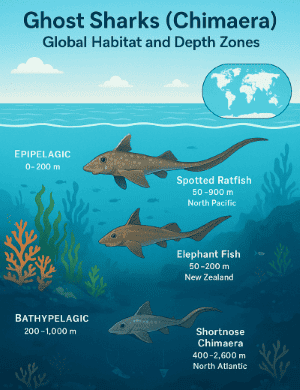Home › Sea Life Facts › Marine › Vertebrates › Sharks › Ghost Sharks
Interesting Facts about Ghost Sharks
[Phylum: Chordata] [Class: Chondrichthyes] [Subclass: Holocephali] [Order: Chimaeriformes]
Most members of the order Chimaeriformes have really strange common names, such as elephant fish, rabbit fish, ratfish, spookfish, and whitefish.
This section contains a collection of weird and wonderful facts about ghost sharks (chimaera), such as where they still exist, what they eat, and how these spooky underwater creatures reproduce.
How Rare is it to See a Living Ghost Shark?
In fact, not being listed as an IUCN endangered species indicates that ghost sharks still occupy a significant geographical range.
So, where exactly do about 40 ghost shark species live, and how deep can these scaleless cartilaginous fishes go?
They are distributed throughout most oceans worldwide, yet they tend to be common in the deepest, darkest, depths of temperate waters.
Even though some species live in relatively shallow water, the general range seems to be between 200 and 2,600 metres (8,500 feet).
For example, the spotted ratfish (Hydrolagus colliei) is a resident along the North Pacific coast. It tolerates the cold waters of Alaska as well as the warmer waters near the Baja California Peninsula in Mexico.
By comparison, the Australian ghostshark (Callorhinchus milii) is considered as being native to the southern parts of Australia and northern New Zealand.
The preferred habitat of ghost sharks are the continental slopes of the Atlantic, Indian, and Southern Oceans. They like to inhabit deep-sea plains where there's a mix of muddy seabeds and rocky outcrops.
Ghost Shark Characteristics
 In truth, sharks are classified as Chondrichthyes, in part because their skeleton is made of cartilage.
In truth, sharks are classified as Chondrichthyes, in part because their skeleton is made of cartilage.
Then, they divide further into 2 Sub-classes, Holocephali (chimaera) and Elasmobranchii (which includes true sharks, skate fish, and marine rays).
Here's the thing:
Living in deep water environments means their habits are low-light or almost completely dark.
Because of this, ghost sharks have big, reflective eyes that are specially adapted for dimly lit conditions and extra long pectoral fins.
Hence, they are capable of tolerating cold water temperatures, typically ranging between 4° and 10° Celsius (39° to 50° Fahrenheit).
What Do Ghost Sharks Eat?
Even though various types of sharks live on the ocean floor, the main eating habits of opportunistic ghost sharks means they also focus on eating small invertebrates and carrion buried in sediment (decaying or dead fish).
So, a typical source of food for these bottom-feeders will be crustaceans (especially clams and crabs), ophiuroids like brittle stars and sea urchins, and deep-sea mollusks.
Interesting Fact: Using three pairs of continuously growing, mineralized tooth plates to crush hard-shelled prey is a way for ghost sharks to control excessive populations of bottom-dwelling invertebrates - an important role in benthic ecosystems.
Types of Ghost Sharks
Andaman Shortnose Chimaera (Chimaera supapae)
Australian Ghostshark (Callorhinchus milii)
Bahamas Ghost Shark (Chimaera bahamaensis)
Black Ghost Shark (Hydrolagus homonycteris)
Brown Chimaera (Chimaera carophila)
Cape Chimaera (Chimaera notafricana)
Carpenter's Chimaera (Chimaera lignaria)
Dark Ghostshark (Hydrolagus novaezealandiae)
Dwarf Sicklefin Chimaera (Neoharriotta carri)
Eastern Pacific Black Ghostshark (Hydrolagus melanophasma)
Falkor Chimaera (Chimaera didierae)
Large-eyed Rabbitfish (Hydrolagus mirabilis)
Marbled Ghostshark Hydrolagus marmoratus
Ogilby's Ghostshark (Chimaera ogilbyi)
Pacific White-spotted Chimaera (Hydrolagus bemisi)
Pale Ghost Fish (Hydrolagus bemisi)
Plough-nosed Chimaera (Callorhinchus)
Rabbit Fish (Chimaera monstrosa)
Seafarer’s Ghostshark (Chimaera willwatchi)
Shortnose Chimaera (Hydrolagus affinis)
Sicklefin Chimaera (Neoharriotta pinnata)
Smallspine Spookfish (Harriotta haeckeli)
Southern Chimaera (Chimaera fulva)
Spotted Ratfish (Hydrolagus colliei)
Whitespot Ghost Shark (Hydrolagus alphus)
How Do Ghost Sharks Reproduce?
The reproductive strategies of chimaeras share some similarities with other shark species. For example, the males use their claspers to fertilise the eggs internally.
But, unlike the true shark taxonomy, male ghost sharks are equipped with a tentacular attachment that protrudes from the top of their forehead. It is a retractable appendage used to grasp a female during the mating process.
But wait - there's more:
Oviparous females also lay cigar-shaped egg capsules (leathery eggcases known as a 'mermaid's purse') that also end up anchored to the ocean floor.
After several months of incubation (up to one year), the embryos emerge from the cases. Yes it is a slow hatching process, but it is one that's particularly well-suited for successful reproductions in deep-sea environments.
Ghost Shark Predators and Threats
Other than some jellyfish species and giant squids, not many animals roam the deep oceans where chimaeras live.
Even so, the ghost shark family is not immune to danger. For example, some of their natural predators include:
- Large carnivorous sharks (especially deep-sea dogfish and sixgill sharks)
- Large bony fish (e.g., Macrouridae (grenadiers or rattails) and deep-sea cod)
- Marine mammals (such as the deep-diving leopard seals and toothed whales)
Chimaeras are easy prey for some deep sea hunters because of their slow movements. Thus, ghost sharks tend to rely on camouflage and depth for safety and protection.
Some of the contributing factors for a decline in some vulnerable regions include certain types of human behaviour (e.g. habitat destruction and degradation, fishing bycatch, ocean garbage pollution, and warming seas).
Related Information and Help Guides
- Daggernose Shark: Facts about Isogomphodon oxyrhynchus
- Viper Dogfish Facts and Information (Trigonognathus kabeyai)
- Underwater Vampires: Can Vampires Live Underwater?
Note: The short video [3:31 minutes] presented by "Deep Marine Scenes" contains even more ghost shark facts and spine-chilling footage of these big-eyed creatures of the deep.